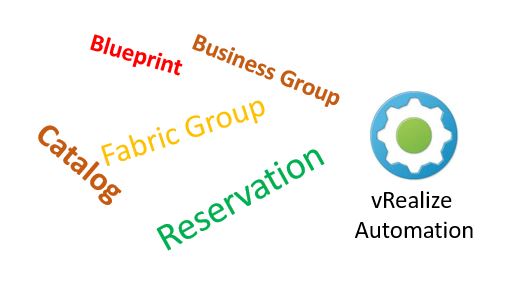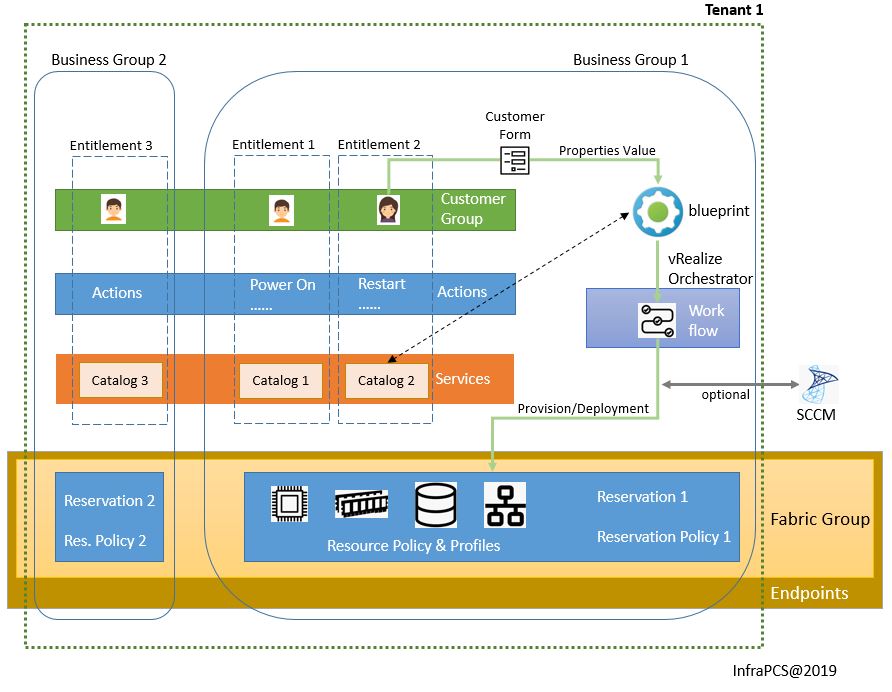When performing the vRealize Automation configuration, there will be some settings need to be configured, like Business group, reservation, blueprint, catalog and etc. This post is to help you to organize and understand these concepts in a different view.

VRealize automation provides an IaaS, Software, and XaaS platform to automate the infrastructure, service and “X” (customer defined services) delivering. In high level, the vRealize automation configuration is to define and solve below questions for VM/Service provisioning:
- Where to deploy?
- Who can deploy?
- How to deploy?
Before we continue to on these three questions, it is necessary to discuss a few governance concepts:
- Tenants – A tenant is an organizational unit in a vRealize Automation deployment. A tenant can represent a business unit in an enterprise or a company that subscribes to cloud services from a service provider. Tenants provide highest level of boundary and segmentation. An example of tenant could be company-A tenant and company-B tenant.
- Business Group – A business group is a collection of machine consumers, often corresponding to a line of business, department, or other organizational unit. To request machines, a vRealize Automation user must belong to at least one business group. Each group has access to a set of local blueprints used to request machines. A business group is located in one tenant. An example of Business Group could be Development BG and Production BG.
Below diagram provide an overview of the relationship of all components and each of them will be discussed in following sections:

Where to deploy?
This part is to define the underlying infrastructure where the virtual machine and services will be deployed to, including on-promise ESXi server, cloud (AWS, Azure etc) and Docker servers for containers.
In this part, below configuration items need to be configured.
- Endpoint: Define the resource the infrastructure, such as vCenter/ESXi, AWS and etc.
- Fabric Group: Define the resources to be used by vRealize from the resources collected from Endpoints.
- Reservations: Reserve the resource from Fabric Group and to be used in selected Business Group.
- Reservation Policy: Restrict machine provisioning to one or more reservations.
Who can deploy?
This part is to define the user and user group and permission control.
In this part, below configuration items need to be configured.
- Customer Group: Configure user groups and assign roles to groups. You can use groups defined in the directory or create custom groups. Both internal and external user/groups are supported, such as Active Directory.
- Catalog: Catalog items are published blueprints, XaaS blueprints, and software components. These blueprints and components are published on the Design tab or using the vRealize Automation API. To make a catalog item available in the service catalog, add the item to a service and then entitle the catalog item to a business group.
- Services: Service is a group of Catalogs and will be entitled to Customer Group.
- Actions: Manage the actions that can be performed on provisioned items.
- Entitlement: This is the configuration item to group above components and define which user (user group) can access which services (catalog associated with it), and the actions you can run on provisioned items.
How to deploy?
This part is to define how the virtual machine or services could be provisioned.
In this part, below configuration items need to be configured.
- Properties (Group): Properties are attributes of objects to define the VM/Service provisioning and these properties will be handle over to vRealize Orchestrator.
- Blueprints: Blueprint defines below items, which are necessary for VM/Service provisioning:
- Required VM/Service specification (Default CPU/Memory/Disk/Storage/Network and etc.)
- Reservation policy (Target infrastructure to host the VM/services.)
- Provision type and workflow (Pre-defined master workflow, which ran by vRealize Orchestrator)
- Properties Groups (Used to communicate with vRealize Orchestrator)
- Each blueprint can be reference as a catalog item, which is used in entitlement.
- Customer Form: Each Blueprint has an associated editable customer form. This is a web page with form and wizard to collect customer input of provisioning properties. The end user will interactive with customer form to request the VM/services by filling the forms.
- Subscription: workflow subscription which can be used to add customized script/workflow to master workflow based on selected conditions. For example, add an email notification when a VM provisioning complete.
For sure, these will be some more settings in VRA configuration, but the above settings have covered the major ones and help to setup VRA easily.

Pingback: Random Short Take #18 | PenguinPunk.net